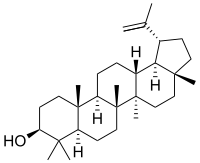Lupeol
 | |
| Names | |
|---|---|
| IUPAC name
(1R,3aR,5aR,5bR,7aR,9S,11aR,11bR,13aR,13bR)-3a,5a,5b,8,8,11a-hexamethyl-1-prop-1-en-2-yl-1,2,3,4,5,6,7,7a,9,10,11,11b,12,13,13a,13b-hexadecahydrocyclopenta[a]chrysen-9-ol | |
| Other names
(3β,13ξ)-Lup-20(29)-en-3-ol; Clerodol; Monogynol B; Fagarasterol; Farganasterol | |
| Identifiers | |
3D model (JSmol) |
|
| ChEMBL | |
| ChemSpider | |
| ECHA InfoCard | 100.008.082 |
PubChem CID |
|
| |
| |
| Properties | |
| C30H50O | |
| Molar mass | 426.73 g·mol−1 |
Except where otherwise noted, data are given for materials in their standard state (at 25 °C [77 °F], 100 kPa). | |
| Infobox references | |
Lupeol is a pharmacologically active triterpenoid. It has several potential medicinal properties.
Natural occurrences
Lupeol is found in a variety of plants, including mango, Acacia visco and Abronia villosa.[1] It is also found in dandelion coffee.
Total synthesis
The first total synthesis of lupeol was reported by Gilbert Stork et al.[2]
In 2009, Surendra and Corey reported a more efficient and enantioselective total synthesis of lupeol, starting from (1E,5E)-8-[(2S)-3,3-dimethyloxiran-2-yl]-2,6-dimethylocta-1,5-dienyl acetate by use of a polycyclization.[3]

Biosynthesis
Lupeol is produced by several organisms from squalene epoxide. Dammarane and baccharane skeletons are formed as intermediates. The reactions are catalyzed by the enzyme lupeol synthase.[4]
Pharmacology
Lupeol has a complex pharmacology, displaying antiprotozoal, antimicrobial, antiinflammatory, antitumor and chemopreventive properties.[5]
Animal models suggest lupeol may act as an anti-inflammatory agent. A 1998 study found lupeol to decrease paw swelling in rats by 39%, compared to 35% for the standardized control compound indomethacin.[6]
One study has also found some activity as a Dipeptidyl peptidase-4 inhibitor and prolyl oligopeptidase inhibitor at high concentrations (in the millimolar range).[7]
It is an effective inhibitor in laboratory models of prostate and skin cancers.[8][9][10]
As an anti-inflammatory agent, lupeol functions primarily on the interleukin system. Lupeol to decreases IL-4 (interleukin 4) production by T-helper type 2 cells.[5][11]
Lupeol has been found to have a contraceptive effect due to its inhibiting effect on the calcium channel of sperm (CatSper).[12]
See also
References
- ↑ Starks, CM; Williams, RB; Norman, VL; Lawrence, JA; Goering, MG; O'Neil-Johnson, M; Hu, JF; Rice, SM; Eldridge, GR (2011). "Abronione, a rotenoid from the desert annual Abronia villosa". Phytochemistry Letters. 4 (2): 72–74. doi:10.1016/j.phytol.2010.08.004. PMC 3099468. PMID 21617767.
- ↑ Stork, Gilbert; Uyeo, Shoichiro; Wakamatsu, T.; Grieco, P.; Labovitz, J. (1971). "Total synthesis of lupeol". Journal of the American Chemical Society. 93 (19): 4945. doi:10.1021/ja00748a068.
- ↑ Surendra, K; Corey, EJ (2009). "A short enantioselective total synthesis of the fundamental pentacyclic triterpene lupeol". Journal of the American Chemical Society. 131 (39): 13928–9. doi:10.1021/ja906335u. PMID 19788328.
- ↑ "Solanum lycopersicum lupeol biosynthesis".
- 1 2 Margareth B. C. Gallo; Miranda J. Sarachine (2009). "Biological activities of Lupeol" (PDF). International Journal of Biomedical and Pharmaceutical Sciences. 3 (Special Issue 1): 46–66. Archived from the original (PDF) on 2010-10-25.
- ↑ Geetha, T; Varalakshmi, P (2001). "Anti-inflammatory activity of lupeol and lupeol linoleate in rats". Journal of Ethnopharmacology. 76 (1): 77–80. doi:10.1016/S0378-8741(01)00175-1. PMID 11378285.
- ↑ Marques, MR; Stüker, C; Kichik, N; Tarragó, T; Giralt, E; Morel, AF; Dalcol, II (2010). "Flavonoids with prolyl oligopeptidase inhibitory activity isolated from Scutellaria racemosa Pers". Fitoterapia. 81 (6): 552–6. doi:10.1016/j.fitote.2010.01.018. PMID 20117183.
- ↑ Prasad S, Kalra N, Singh M, Shukla Y (2008). "Protective effects of lupeol and mango extract against androgen induced oxidative stress in Swiss albino mice" (PDF). Asian J Androl. 10 (2): 313–8. doi:10.1111/j.1745-7262.2008.00313.x. PMID 18097535.
- ↑ Nigam N, Prasad S, Shukla Y (2007). "Preventive effects of lupeol on DMBA induced DNA alkylation damage in mouse skin". Food Chem Toxicol. 45 (11): 2331–5. doi:10.1016/j.fct.2007.06.002. PMID 17637493.
- ↑ Saleem M, Afaq F, Adhami VM, Mukhtar H (2004). "Lupeol modulates NF-kappaB and PI3K/Akt pathways and inhibits skin cancer in CD-1 mice". Oncogene. 23 (30): 5203–14. doi:10.1038/sj.onc.1207641. PMID 15122342.
- ↑ Bani S, Kaul A, Khan B, Ahmad SF, Suri KA, Gupta BD, Satti NK, Qazi GN (2006). "Suppression of T lymphocyte activity by lupeol isolated from Crataeva religious". Phytotherapy Research. 20 (4): 279–287. doi:10.1002/ptr.1852. PMID 16557610.
- ↑ Nadja Mannowetza, Melissa R. Millera, and Polina V. Lishko (2017). "Regulation of the sperm calcium channel CatSper by endogenous steroids and plant triterpenoids". Proceedings of the National Academy of Sciences of the United States of America. 114 (22): 5743–5748. doi:10.1073/pnas.1700367114. PMC 5465908. PMID 28507119.